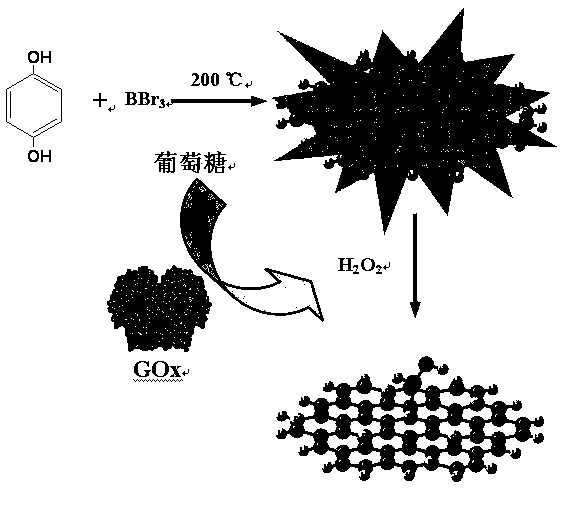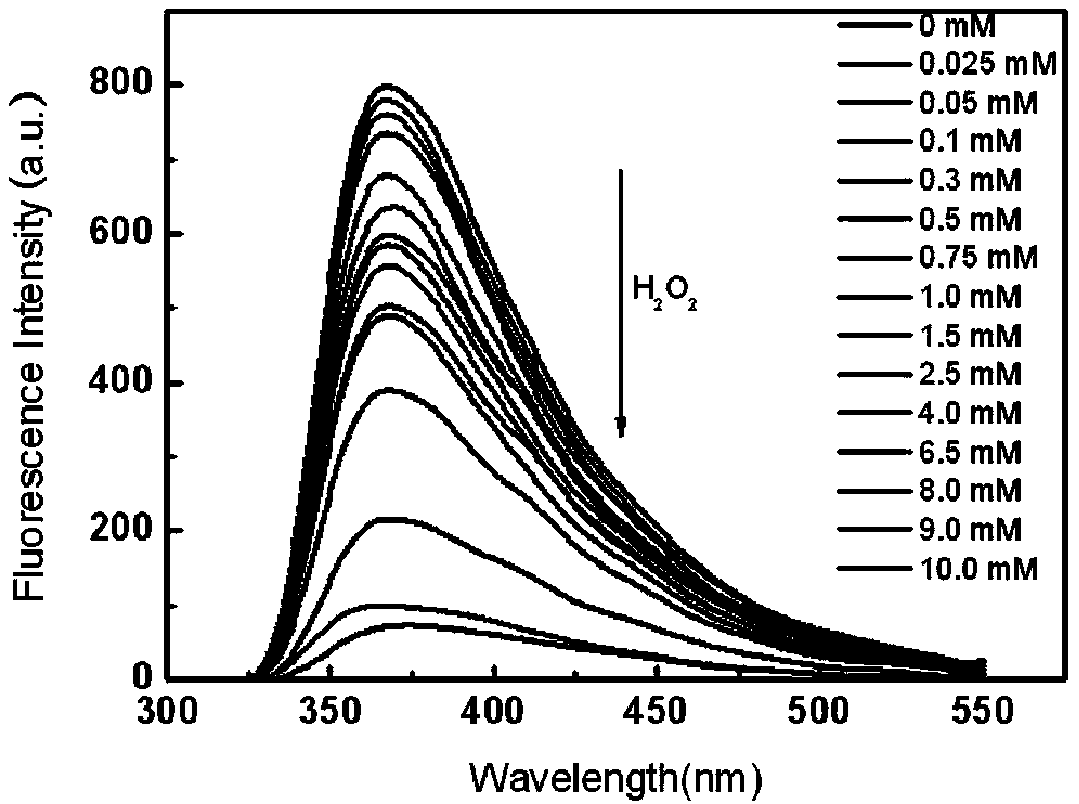Method for preparing boron-doped carbon quantum dots by one-step solvothermal method and application of boron-doped carbon quantum dots
A technology of carbon quantum dots and solvothermal method, applied in chemical instruments and methods, fluorescence/phosphorescence, luminescent materials, etc., can solve problems such as sensor interference, achieve high sensitivity, good biocompatibility, and simple preparation process equipment Effect
- Summary
- Abstract
- Description
- Claims
- Application Information
AI Technical Summary
Problems solved by technology
Method used
Image
Examples
Embodiment 1
[0031] Embodiment 1: The method for preparing boron-doped carbon quantum dots by one-step solvothermal method
[0032] Such as figure 1 As shown, weigh 1.0g of hydroquinone, place it in a 25mL stainless steel autoclave lined with polytetrafluoroethylene, add 5mL of acetone to dissolve, pipette 2.58mL of boron tribromide and slowly drop it into the above reaction kettle In the process, the sealed reactor was placed in a blast drying oven and heated at 200°C for 2 hours. When the autoclave is cooled to room temperature, the mixed liquid in the autoclave is concentrated and evaporated to dryness by means of rotary evaporation to obtain boron-doped carbon quantum dots. Such as figure 2 The aTEM imaging results in the paper show that the prepared boron-doped carbon quantum dots are approximately spherical, uniform in size, good in dispersion, without agglomeration, and the particle size is mainly distributed in the range of 8-22nm. Such as figure 2 The high-resolution transm...
Embodiment 2
[0036] Embodiment 2: The method for preparing boron-doped carbon quantum dots by one-step solvothermal method
[0037] Such as figure 1 As shown, weigh 1.0g of hydroquinone, place it in a 25mL stainless steel high-pressure reactor lined with polytetrafluoroethylene, add 5mL of acetone to dissolve, pipette 1.72mL of boron tribromide and slowly drop it into the above reactor In the process, the sealed reactor was placed in a blast drying oven and heated at 220° C. for 5 hours. When the autoclave is cooled to room temperature, the mixed liquid in the autoclave is concentrated and evaporated to dryness by means of rotary evaporation to obtain boron-doped carbon quantum dots.
[0038] Use the reference method to measure the fluorescence quantum yield, the calculation formula is: Ф=Ф S [(I·A s n 2 ) / (I s ·A·n s 2 )](Ф represents the quantum yield, I represents the integral area of the fluorescence emission spectrum excited by the optimal excitation wavelength, A represents...
Embodiment 3
[0041] Embodiment 3: The method for preparing boron-doped carbon quantum dots by one-step solvothermal method
[0042] Such as figure 1 As shown, weigh 1.0g of hydroquinone, place it in a 25mL stainless steel autoclave lined with polytetrafluoroethylene, add 5mL of acetone to dissolve, pipette 0.86mL of boron tribromide and slowly drop it into the above reaction kettle , the sealed reactor was placed in a forced air oven and heated at 150°C for 1 hour. When the autoclave is cooled to room temperature, the mixed liquid in the autoclave is concentrated and evaporated to dryness by means of rotary evaporation to obtain boron-doped carbon quantum dots.
[0043] Use the reference method to measure the fluorescence quantum yield, the calculation formula is: Ф=Ф S [(I·A s n 2 ) / (I s ·A·n s 2 )](Ф represents the quantum yield, I represents the integral area of the fluorescence emission spectrum excited by the optimal excitation wavelength, A represents the absorbance at the ...
PUM
 Login to View More
Login to View More Abstract
Description
Claims
Application Information
 Login to View More
Login to View More - R&D
- Intellectual Property
- Life Sciences
- Materials
- Tech Scout
- Unparalleled Data Quality
- Higher Quality Content
- 60% Fewer Hallucinations
Browse by: Latest US Patents, China's latest patents, Technical Efficacy Thesaurus, Application Domain, Technology Topic, Popular Technical Reports.
© 2025 PatSnap. All rights reserved.Legal|Privacy policy|Modern Slavery Act Transparency Statement|Sitemap|About US| Contact US: help@patsnap.com



